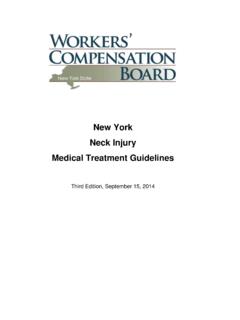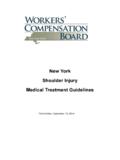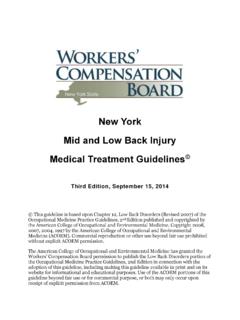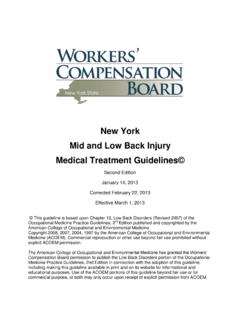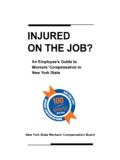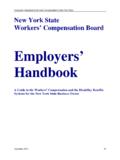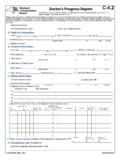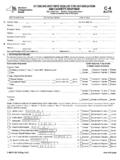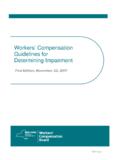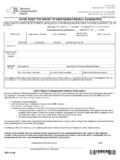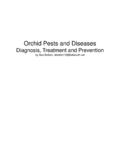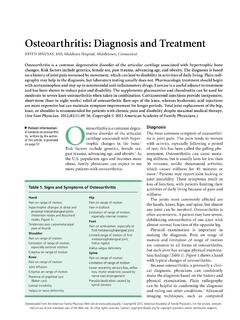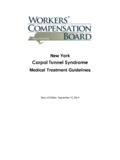Transcription of New York Non-Acute Pain Medical Treatment Guidelines
1 New York Non-Acute pain Medical Treatment Guidelines first Edition, September 15, 2014 New York State Workers' Compensation Board New York Non-Acute pain Medical Treatment Guidelines first Edition, September 15, 2014 i Table of Contents GENERAL GUIDELINE PRINCIPLES .. 1 Medical CARE .. 1 RENDERING OF Medical SERVICES .. 1 POSITIVE PATIENT RESPONSE .. 1 RE-EVALUATE Treatment .. 1 EDUCATION .. 2 DIAGNOSTIC TIME FRAMES .. 2 Treatment TIME FRAMES .. 2 DELAYED RECOVERY .. 2 ACTIVE INTERVENTIONS .. 3 ACTIVE THERAPEUTIC EXERCISE PROGRAM .. 3 DIAGNOSTIC IMAGING AND TESTING PROCEDURES .. 3 SURGICAL INTERVENTIONS .. 4 PRE-AUTHORIZATION .. 4 PERSONALITY/PSYCHOLOGICAL/PSYCHOSOCIAL EVALUATIONS .. 4 PERSONALITY/PSYCHOLOGICAL/PSYCHOSOCIAL INTERVENTION .. 5 FUNCTIONAL CAPACITY EVALUATION (FCE) .. 5 RETURN TO WORK .. 6 JOB SITE EVALUATION .. 6 GUIDELINE RECOMMENDATIONS AND Medical EVIDENCE.
2 7 EXPERIMENTAL/INVESTIGATIONAL Treatment .. 7 INJURED WORKERS AS PATIENTS .. 7 SCOPE OF PRACTICE .. 7 DEFINITION OF Non-Acute pain .. 7 INTRODUCTION .. 8 KEY CONCEPTS .. 8 Biomedical vs. Biopsychosocial Approaches to the Diagnosis, Treatment and Management of pain .. 8 Medical vs. Self-Management Model .. 10 New York State Workers' Compensation Board New York Non-Acute pain Medical Treatment Guidelines first Edition, September 15, 2014 ii Delayed Recovery .. 11 Importance of Early Identification .. 11 Functional Restoration Approach to Non-Acute pain Management ..12 pain Outcomes and Summary .. 13 EVALUATION AND DIAGNOSTIC PROCEDURES .. 13 HISTORY TAKING AND PHYSICAL EXAMINATION (HX & PE) .. 13 pain History, History of Present Illness .. 13 Past Medical History .. 15 Physical Examination .. 17 Red Flags .. 18 PERSONALITY/ PSYCHOLOGICAL/PSYCHOSOCIAL CLINICAL EVALUATION FOR pain MANAGEMENT.
3 18 Clinical Evaluation .. 19 Tests of Psychological Functioning .. 20 DIAGNOSTIC STUDIES (Imaging, Electrodiagnostic Studies (EDX), Special Testing, Laboratory Testing) .. 21 NON-PHARMACOLOGICAL APPROACHES .. 21 DELAYED RECOVERY .. 21 PSYCHOLOGICAL EVALUATION AND INTERVENTION .. 22 Evaluation .. 22 Intervention .. 23 NON-PHARMACOLOGIC Treatment OPTIONS .. 24 Non-Acute pain MANAGEMENT PROGRAMS (INTERDISCIPLINARY OR FUNCTIONAL RESTORATION pain MANAGEMENT PROGRAM) .. 24 Interdisciplinary or functional restoration program .. 24 Core components of an interdisciplinary pain program .. 24 MULTIDISCIPLINARY PROGAMS .. 25 GOALS OF pain MANAGEMENT PROGRAMS .. 25 TYPES OF PROGRAMS .. 26 DURATION OF PROGRAMS/INTERVENTIONS .. 26 New York State Workers' Compensation Board New York Non-Acute pain Medical Treatment Guidelines first Edition, September 15, 2014 iii Inpatient or Outpatient pain Management Programs.
4 26 Cognitive Behavioral Therapy .. 26 Psychological Evaluations .. 27 Psychological Intervention .. 27 Biofeedback .. 27 PHARMACOLOGICAL APPROACHES .. 28 NON-OPIOID MEDICATIONS AND Medical MANAGEMENT .. 28 Introduction .. 28 Goals .. 28 Pharmacological Principles .. 28 Neuropathic pain .. 29 Medications .. 30 OPIOIDS: INITIATING, TRANSITIONING AND MANAGING LONG-TERM ORAL OPIOIDS .. 39 Long-Term Use of Opioids in the Opioid-Na ve Patient: Opioid Therapeutic Trial .. 39 Long-Term Use of Opioids: Transitioning/Managing Patients ON Existing Opioid Therapy .. 43 Ongoing, Long-Term Opioid Management .. 45 Guidelines for Optimizing Opioid Treatment .. 48 Introduction .. 48 Assessing Effects of Long-Term Opioid Therapy .. 48 Patient Informed Consent for Opioid Treatment Form and Patient Understanding for Opioid Treatment Form .. 51 Urine Drug Testing (UDT) for Monitoring Opioid 53 Optimizing Opioid Doses.
5 58 OPIOID-RELATED MEDICATIONS: Tramadol, Methadone, Buprenorphine, Tapentadol .. 69 Tramadol .. 69 Methadone .. 70 Buprenorphine .. 70 Tapentadol .. 71 New York State Workers' Compensation Board New York Non-Acute pain Medical Treatment Guidelines first Edition, September 15, 2014 iv SPINAL CORD STIMULATOR AND INTRATHECAL DRUG DELIVERY .. 72 IMPLANTABLE SPINAL CORD STIMULATOR (SCS) .. 72 Indications .. 72 SCS Neurostimulation Screening Trial .. 73 Permanent SCS Implantation .. 74 Special Circumstances .. 74 INTRATHECAL DRUG DELIVERY ( pain Pumps) .. 74 Indications .. 75 pain Pump Screening Trial .. 75 pain Pump Implantation .. 76 FUNCTIONAL MAINTENANCE CARE .. 76 General Recommendations for Functional Maintenance Care .. 76 Ongoing, Independent, Self-Management Plan .. 76 Self-Directed pain Management Plan .. 77 Review of Self-Management and Self-Directed Treatment Programs .. 77 Ongoing Care.
6 77 Ongoing Maintenance Care .. 78 APPENDIX A: Fear-Avoidance Beliefs Questionnaire (FABQ) .. 80 APPENDIX B: Frequently Used Tests of Psychological Functioning .. 82 1. Comprehensive Inventories for Medical Patients .. 82 A. Battery for Health Improvement, 2nd Edition (BHI-2 ) .. 82 B. Millon Behavioral Medical Diagnostic (MBMD ) .. 82 2. Comprehensive Psychological Inventories .. 82 A. Millon Clinical Multiaxial Inventory , 3rd Edition (MCMI- III ) .. 83 B. Minnesota Multiphasic Personality Inventory , 2nd Edition (MMPI-2 ) .. 83 C. Minnesota Multiphasic Personality Inventory , 2nd Edition Revised Form (MMPI-2 ) .. 83 D. Personality Assessment Inventory (PAI) .. 83 3. Brief Multidimensional Screens for Medical Patients .. 84 A. Brief Battery for Health Improvement, 2nd Edition (BBHI-2 ) .. 84 New York State Workers' Compensation Board New York Non-Acute pain Medical Treatment Guidelines first Edition, September 15, 2014 v B.
7 pain Patient Profile (P3 ) .. 84 C. SF-36 .. 85 D. McGill pain Questionnaire (MPQ) .. 85 E. Oswestry Disability Questionnaire (ODQ) .. 85 F. Visual Analog Scales (VAS) .. 85 G. Numerical Rating Scales (NRS) .. 86 4. Brief Multidimensional Screens for Psychiatric Patients .. 86 A. Brief Symptom Inventory (BSI ) .. 86 B. Brief Symptom Inventory 18 (BSI-18 ) .. 86 C. Symptom Check List 90 (SCL 90) .. 87 5. Brief Specialized Psychiatric Screening Measures .. 87 A. Beck Depression Inventory (BDI) .. 87 B. Post Traumatic Stress Diagnostic Scale (PDS ) .. 87 C. Center of Epidemiologic Studies Depression 87 D. Brief Patient Health Questionnaire from PRIME - MD .. 88 E. Zung Questionnaire .. 88 APPENDIX C: pain Assessment and Documentation Tool (PADT) .. 89 APPENDIX D: Dosing Thresholds for Selected Opioids .. 91 APPENDIX E: Urine Drug Testing .. 94 APPENDIX F: Patient Informed Consent For Opioid Treatment Form.
8 100 APPENDIX G: Patient Understanding For Opioid Treatment Form .. 101 Bibliography .. 102 .. 109 New York State Workers' Compensation Board New York Non-Acute pain Medical Treatment Guidelines first Edition, September 15, 2014 1 GENERAL GUIDELINE PRINCIPLES The principles summarized in this section are key to the intended application of the New York State Medical Treatment Guidelines (MTG). Medical Care Medical CARE Medical care and Treatment required as a result of a work-related injury should be focused on restoring functional ability required to meet the patient s daily and work activities and return to work, while striving to restore the patient s health to its pre-injury status in so far as is feasible. RENDERING OF Medical SERVICES Any Medical provider rendering services to a workers compensation patient must utilize the Treatment Guidelines as provided for with respect to all work-related injuries and/or illnesses.
9 POSITIVE PATIENT RESPONSE Positive results are defined primarily as functional gains which can be objectively measured. Objective functional gains include, but are not limited to, positional tolerances, range of motion, strength, endurance, activities of daily living (ADL), cognition, psychological behavior, and efficiency/velocity measures which can be quantified. Subjective reports of pain and function should be considered and given relative weight when the pain has anatomic and physiologic correlation. RE-EVALUATE Treatment If a given Treatment or modality is not producing expected results, the provider should either modify or discontinue the Treatment regime. The provider should evaluate the efficacy of the Treatment or modality 2 to 3 weeks after the initial visit and 3 to 4 weeks thereafter. Recognizing that Treatment failure is at times attributable to an incorrect diagnosis should prompt the clinician to reconsider the diagnosis in the event of an unexpected poor response to an otherwise rational intervention.
10 New York State Workers' Compensation Board New York Non-Acute pain Medical Treatment Guidelines first Edition, September 15, 2014 2 Education EDUCATION Education of the patient and family, as well as the employer, insurer, policy makers and the community should be a primary emphasis in the Treatment of work-related injury or illness. Practitioners should develop and implement effective educational strategies and skills. An education-based paradigm should always start with communication providing reassuring information to the patient. No Treatment plan is complete without addressing issues of individual and/or group patient education as a means of facilitating self-management of symptoms and prevention of future injury. Time Frames DIAGNOSTIC TIME FRAMES Diagnostic time frames for conducting diagnostic testing commence on the date of injury. Clinical judgment may substantiate the need to accelerate or decelerate the time frames discussed in this document.
